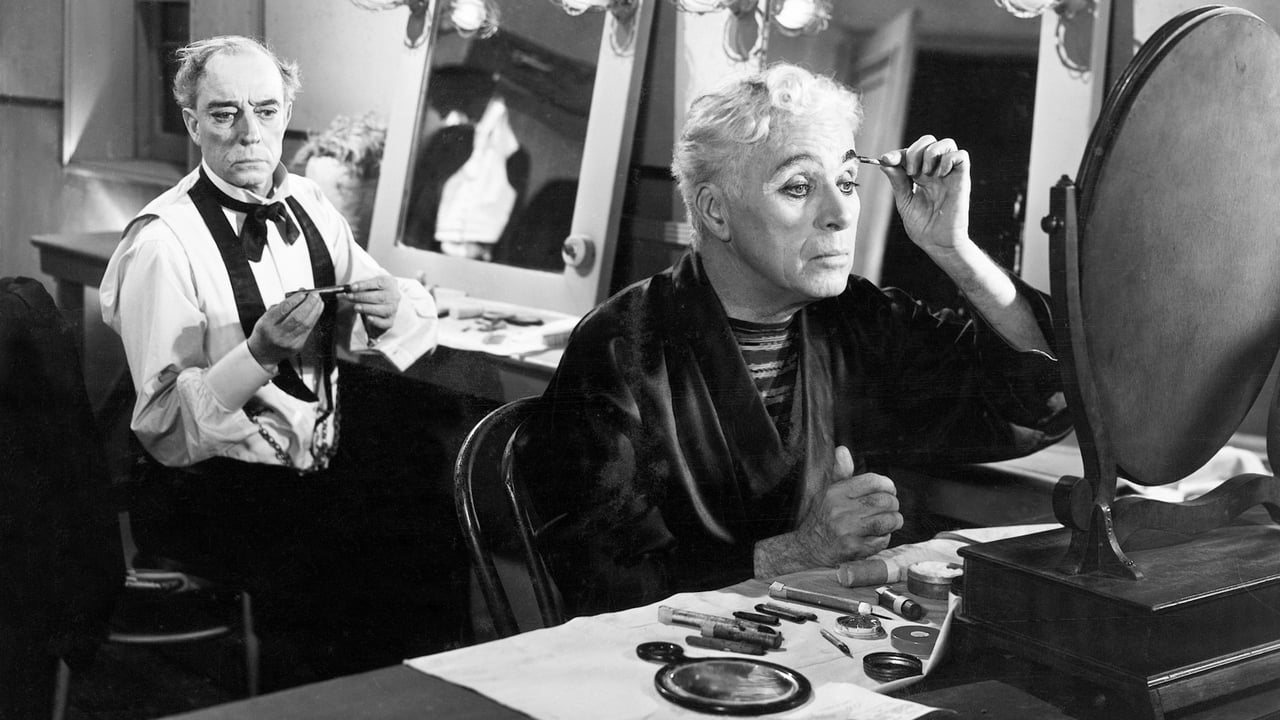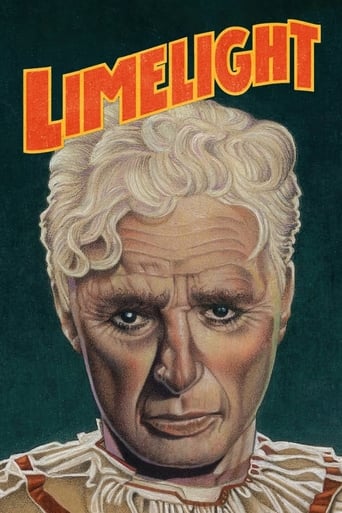

A Masterpiece!
... View MoreA Brilliant Conflict
... View MoreYour blood may run cold, but you now find yourself pinioned to the story.
... View MoreA great movie, one of the best of this year. There was a bit of confusion at one point in the plot, but nothing serious.
... View MoreCalvero remands me the Chaplin taking the honorary Oscar in 1972. his words. his emotion. his presence as gallery of so many characters. not only for the links between the clown and its interpreter. but for the bitter delicacy who reflects the fight and passion and sacrifices of an entire career. Limelight could be perceived as artificial and prisoner of clichés. the comedy has not the force from another Chaplin's works. the speeches of the artist are more didacticism. but that is the purpose. to open a door who seems a wall. to present love in a different light and angle. to show the artist out of its art-cocoon. the virtue of Limelight is to be a precious naked honest confession. about life not about art. about force of decision. about joy and success and truth. about the other as part from you. the presence of Buster Keaton. the performance of Claire Bloom. the large slices of mannerism. each as piece not for a masterpiece because nothing need demonstrated. but as a precise look in heart of small things who defines each existence. it is not a film for applause or for great eulogies. it is bitter film using almost well known theme. but it has the force to imagine a way to remind the man and not the brilliant actor. Calvero has not exactly a character. it is a fragile confession from a great man about himself and about his vision about the existence.
... View MoreMost ordinary people fall into a role and a persona in their lives, and tend to not veer very far from it if it provides for them. Perhaps, due to extreme situations, they may find it necessary to reinvent themselves once or twice and rise to the occasion or fall into dissolution.An artist like Chaplain had to reinvent himself over and over again over four decades, particularly in a medium that was changing every few years. That's probably why he had so many failed marriages with younger woman; he had to feel like a "player" to keep the flow going and fight back the doubt and anxiety (and the terror of becoming irrelevant) that inevitably begins to haunt creative men in their twilight years. Don't underestimate the power of sex magic!Limelight is a film about those demons, and the immense courage (and yes, the love of a much younger woman, too, doesn't hurt), that is required to triumph over them. Still, everyone knows there is one specter that no man can outrun -- Death. Chaplain masks this existential dimension in layers of sentimental melodrama which you will have to decide for yourself is effective, but I think he does this intentionally to smuggle in some deep and darker themes that filmmakers like Bergman would become famous for continually exploring masterfully.I found myself going back and forth with Limelight; there are times when the melodrama overpowers the film, and the pedestrian cinematography doesn't help matters. A few times I felt like I was watching the old Abbot and Costello TV show, particularly the apartment scenes. However, Chaplain is such an immense presence you can't help be engaged and encouraged to keep watching because you want so much for his character Calvero to triumph. His co-star, Claire Bloom, is quite effective, too, and she has several "looks" in this film to contrast and mirror the ongoing struggle the old comedian in having internally.Getting on in years myself, and feeling washed up and without hope and purpose, Calvero's plight and faltering desire to once again command the Limelight was quite cathartic. I was amazed by his final performance with Keaton; when Calvero starts rocking that violin like Eddie Van Halen in his prime, I was in a state of sublime fascination. Here was a true artist giving everything up for his audience, feeling the peak thrill of having the audience at his command once again for a few fleeting moments; a thrill that, tragically, he will pay dearly for. We can only hope that we, too, can earn such an exalted death as Calvero's. Perhaps that is Chaplain's hidden message in this film; that life is, in the final analysis, about striving for a death that ennobles those you leave behind.
... View MoreBefore seeing Limelight, I thought Chaplin's three masterpieces are 'The Gold Rush', 'City Lights', and 'Modern Times'. "The Great Dictator" makes me crying, in the last scene as well as 'The Kid'. Today, when I see Limelight, I was disturbed, I was ill-treated, I was very much disturbed. But after the film, I couldn't help but saying a word - The Greatest artist of all time. As a director, he is a master of misen-en-scene, in the beautiful scenes, interiors of Gold Rush, Modern Times - but Limelight, I can't think he couldn't make a film like this. As a director of Modern age, it is as tough to make a film like silent ages, and as a king of silent age, it was also very tough to make a film like Limelight. He was a king in music, and so was his theme. And one can feel what a true artist should be. Remember the very last scene, The king was dying, and then camera was slightly tracking back, then the close shot of his beloved...she was still dancing, seeing her king of heart dying...yet, as a artist her 1st preference was her art..Brilliant..not a clown..but the greatest Artist..Yes remembering all field..THE GREATEST ARTIST OF ALL TIME.
... View MoreAfter almost half a century in the USA for whom among other things he sold war bonds in two World Wars, Charlie Chaplin got his walking papers from our government. And maybe the unkindest cut of all was that he got them as Limelight was premiering. Chaplin had retired his little tramp character after Modern Times and he conceded that sound was here to stay. But the tramp kind of made a comeback in this film. As for Chaplin this film is about the old age of a performer who knows nothing else and a last touch of romance in his senior years.Making her debut in Limelight is Claire Bloom and she plays a fragile young thing with hopes of being a prima ballerina who tries to take her own life with gas. Charlie who also rents a room in the same boardinghouse saves her and the two begin a relationship of sorts. He's a once famous comedian who has seen his best days as public tastes change and takes solace in alcohol as the fuel to keep him going. But she provides him a reason to live other than to drown his sorrows and Chaplin provides Bloom with hope and tenderness.Charlie who took a great deal of this story from A Star Is Born works some real wonders here. One thing about Chaplin films, they were his personal projects even more than Orson Welles. He wrote, produced, directed, did the music and starred in Limelight and unlike Welles never had to worry about who would release his films, he was a founding partner of United Artists. I was going to make a crack that he didn't do the choreography and then read as the film concluded he did have a hand in it. Was there no limit to this man's talents?Limelight is most famous for Charlie doing a once in a life time duo act with his silent comic rival Buster Keaton. The two do a very funny routine with a violin and piano. Chaplin worked on his projects only, Keaton however was starting to come back if not as a headliner, as a reliable character player in a lot of films that were way beneath what he had been before.The performance pieces were nice, but the real key to Limelight is Chaplin expressing his opinions on love and life and how precious both are. The only time I heard it expressed as well is by Burt Lancaster in Birdman Of Alcatraz. It's all quite profound for a clown.
... View More